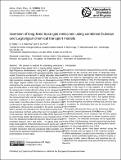| dc.contributor.author | Manning, Alistair J. | |
| dc.contributor.author | Rigby, Matthew | |
| dc.contributor.author | Prinn, Ronald G. | |
| dc.date.accessioned | 2012-04-13T18:06:32Z | |
| dc.date.available | 2012-04-13T18:06:32Z | |
| dc.date.issued | 2011-09 | |
| dc.date.submitted | 2011-08 | |
| dc.identifier.issn | 1680-7324 | |
| dc.identifier.issn | 1680-7316 | |
| dc.identifier.uri | http://hdl.handle.net/1721.1/70030 | |
| dc.description | Supplement related to this article is available online at: http://www.atmos-chem-phys.net/11/9887/2011/acp-11-9887-2011-supplement.zip. | en_US |
| dc.description.abstract | We present a method for estimating emissions of long-lived trace gases from a sparse global network of high-frequency observatories, using both a global Eulerian chemical transport model and Lagrangian particle dispersion model. Emissions are derived in a single step after determining sensitivities of the observations to initial conditions, the high-resolution emissions field close to observation points, and larger regions further from the measurements. This method has the several advantages over inversions using one type of model alone, in that: high-resolution simulations can be carried out in limited domains close to the measurement sites, with lower resolution being used further from them; the influence of errors due to aggregation of emissions close to the measurement sites can be minimized; assumptions about boundary conditions to the Lagrangian model do not need to be made, since the entire emissions field is estimated; any combination of appropriate models can be used, with no code modification. Because the sensitivity to the entire emissions field is derived, the estimation can be carried out using traditional statistical methods without the need for multiple steps in the inversion. We demonstrate the utility of this approach by determining global SF6 emissions using measurements from the Advanced Global Atmospheric Gases Experiment (AGAGE) between 2007 and 2009. The global total and large-scale patterns of the derived emissions agree well with previous studies, whilst allowing emissions to be determined at higher resolution than has previously been possible, and improving the agreement between the modeled and observed mole fractions at some sites. | en_US |
| dc.language.iso | en_US | |
| dc.publisher | Copernicus GmbH | en_US |
| dc.relation.isversionof | http://dx.doi.org/10.5194/acp-11-9887-2011 | en_US |
| dc.rights | Creative Commons Attribution 3.0 | en_US |
| dc.rights.uri | http://creativecommons.org/licenses/by/3.0/ | en_US |
| dc.source | Copernicus | en_US |
| dc.title | Inversion of long-lived trace gas emissions using combined Eulerian and Lagrangian chemical transport models | en_US |
| dc.type | Article | en_US |
| dc.identifier.citation | Rigby, M., A. J. Manning, and R. G. Prinn. “Inversion of Long-lived Trace Gas Emissions Using Combined Eulerian and Lagrangian Chemical Transport Models.” Atmospheric Chemistry and Physics 11.18 (2011): 9887–9898. Web. 13 Apr. 2012. | en_US |
| dc.contributor.department | Massachusetts Institute of Technology. Center for Global Change Science | en_US |
| dc.contributor.approver | Prinn, Ronald G. | |
| dc.contributor.mitauthor | Rigby, Matthew | |
| dc.contributor.mitauthor | Prinn, Ronald G. | |
| dc.relation.journal | Atmospheric Chemistry and Physics | en_US |
| dc.eprint.version | Final published version | en_US |
| dc.type.uri | http://purl.org/eprint/type/JournalArticle | en_US |
| eprint.status | http://purl.org/eprint/status/PeerReviewed | en_US |
| dspace.orderedauthors | Rigby, M.; Manning, A. J.; Prinn, R. G. | en |
| dc.identifier.orcid | https://orcid.org/0000-0001-5925-3801 | |
| mit.license | PUBLISHER_CC | en_US |
| mit.metadata.status | Complete | |
